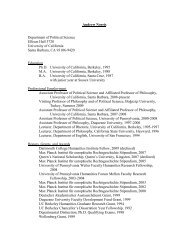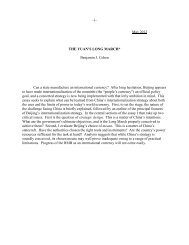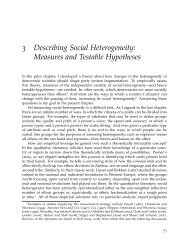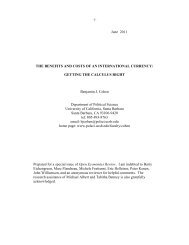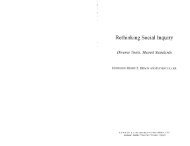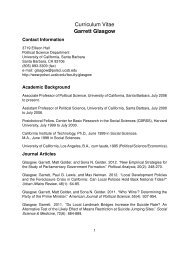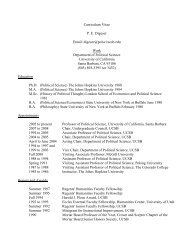Article - Department of Political Science
Article - Department of Political Science
Article - Department of Political Science
Create successful ePaper yourself
Turn your PDF publications into a flip-book with our unique Google optimized e-Paper software.
P1: FJJ<br />
WV002-02 December 16, 1999 11:24<br />
<strong>Political</strong> Analysis, 8:2<br />
Two-Stage Estimation<br />
<strong>of</strong> Nonrecursive Choice Models<br />
R. Michael Alvarez and Garrett Glasgow<br />
California Institute <strong>of</strong> Technology<br />
Questions <strong>of</strong> causation are important issues in empirical research on political behavior.<br />
Most <strong>of</strong> the discussion <strong>of</strong> the econometric problems associated with multiequation models<br />
with reciprocal causation has focused on models with continuous dependent variables<br />
(e.g., Markus and Converse 1979; Page and Jones 1979). Yet, many models <strong>of</strong> political<br />
behavior involve discrete or dichotomous dependent variables; this paper describes two<br />
techniques which can consistently estimate reciprocal relationships between dichotomous<br />
and continuous dependent variables. The first, two-stage probit least squares (2SPLS),<br />
is very similar to two-stage instrumental variable techniques. The second, two-stage conditional<br />
maximum likelihood (2SCML), may overcome problems associated with 2SPLS,<br />
but has not been used in the political science literature. We demonstrate the potential<br />
pitfalls <strong>of</strong> ignoring the problems <strong>of</strong> reciprocal causation in nonrecursive choice models<br />
and examine the properties <strong>of</strong> both techniques using Monte Carlo simulations: we find<br />
that 2SPLS slightly outperforms 2SCML in terms <strong>of</strong> bias but that 2SCML produces more<br />
accurate standard errors. However, the 2SCML model <strong>of</strong>fers an explicit statistical test<br />
for endogeneity. The results from our simulations, and the statistical test for exogeneity,<br />
lead us to advocate the use <strong>of</strong> 2SCML for estimation <strong>of</strong> this class <strong>of</strong> causal models. We<br />
then apply both <strong>of</strong> these techniques to an empirical example focusing on the relationship<br />
between voter preferences in a presidential election and the voter’s uncertainty about the<br />
policy positions taken by the candidates. This example demonstrates the importance <strong>of</strong><br />
these techniques for political science research.<br />
1 Introduction<br />
MANY INTERESTING ASPECTS <strong>of</strong> political behavior involve dichotomous decisions.<br />
For example, a potential voter decides whether to go to the polls on election day (Wolfinger<br />
and Rosenstone 1980), activists decide to donate time or resources to a campaign (Verba<br />
and Nie 1972), and candidates decide to enter particular races in certain political contexts<br />
(Jacobson and Kernell 1981). One <strong>of</strong> the most studied dichotomous choices, though, occurs<br />
once a citizen has entered the voting booth, since in American national elections voters<br />
essentially have two ways to cast their ballot—for Democratic or Republican candidates.<br />
While sometimes there are other viable choices in each <strong>of</strong> these examples, much <strong>of</strong> the<br />
empirical research in political behavior has examined binary choices.<br />
Authors’ note: John Aldrich, John Brehm, Tara Butterfield, Jonathan Katz, Eric Lawrence, and Jonathan Nagler<br />
provided important comments and advice. Abby Delman and Gail Nash gave invaluable assistance. The John M.<br />
Olin Foundation provided support for part <strong>of</strong> this research, as did the National <strong>Science</strong> Foundation through Grant<br />
SBR-9709372.<br />
Copyright 1999 by the Society for <strong>Political</strong> Methodology<br />
147
P1: FJJ<br />
WV002-02 December 16, 1999 11:24<br />
148 R. Michael Alvarez and Garrett Glasgow<br />
The practical econometric difficulties associated with dichotomous dependent variables<br />
are now well known in political research. Given that ordinary least squares does not perform<br />
well when the dependent variable is binary, researchers now turn to linear probability, logit,<br />
or probit models (Achen 1986; Aldrich and Nelson 1984). In either framework, under<br />
certain assumptions, the dichotomous nature <strong>of</strong> the dependent variable is not an obstacle to<br />
unbiased estimation <strong>of</strong> model coefficients.<br />
However, researchers using these dichotomous dependent variable models have not<br />
incorporated them adequately into larger nonrecursive models <strong>of</strong> political behavior. In fact,<br />
the prominent examples <strong>of</strong> nonrecursive models in the literature either have introduced<br />
surrogate variables for binary candidate choices (e.g., Page and Jones 1979) or have resorted<br />
to least squares estimation <strong>of</strong> a discrete choice model (e.g., Markus and Converse 1979).<br />
In only a few instances have researchers dealt with the problems <strong>of</strong> endogeneity in discrete<br />
choice models in political science, with the most notable being models <strong>of</strong> party identification<br />
(Franklin and Jackson 1983; Fiorina 1981), interest group lobbying (Caldeira and Wright<br />
1998), and tax compliance (Schotz and Lubell 1998), all estimated using some type <strong>of</strong> twostage<br />
technique. But little is known about the statistical properties <strong>of</strong> two-stage estimation <strong>of</strong><br />
models involving discrete and continuous dependent variables, making it difficult to assess<br />
the reliability <strong>of</strong> the published empirical results using two-stage estimation techniques.<br />
We begin the next section <strong>of</strong> this paper with an examination <strong>of</strong> two techniques which can<br />
be used to estimate reciprocal relationships between dichotomous and continuous dependent<br />
variables. One technique, two-stage probit least squares (2SPLS), is similar to two-stage<br />
instrumental variable techniques. The second technique, two-stage conditional maximum<br />
likelihood (2SCML), might alleviate some <strong>of</strong> the shortcomings <strong>of</strong> 2SPLS, but has not<br />
seen widespread use in the political science literature. We then examine the properties <strong>of</strong><br />
both 2SPLS and 2SCML through Monte Carlo simulations and compare these results to<br />
those obtained with a model that does not correct for endogeneity. Finally, we show the<br />
applicability <strong>of</strong> both models to a problem <strong>of</strong> contemporary interest.<br />
2 Nonrecursive Two-Stage Choice Models<br />
We begin this discussion with a simple two-variable nonrecursive system: 1<br />
y1 ∗ = γ 1y 2 + β 1 X 1 + µ 1 (1)<br />
y 2 = γ 2 y1 ∗ + β 2 X 2 + µ 2 (2)<br />
where y 2 is a continuous variable, X 1 and X 2 are independent variables, µ 1 and µ 2 are error<br />
terms, and γ and β are parameters to be estimated. We do not directly observe the value <strong>of</strong><br />
y1 ∗, instead observing: {<br />
1 if y<br />
∗<br />
y 1 =<br />
1<br />
> 0<br />
0 if y1 ∗ ≤ 0<br />
1 The variables in these and the following equations should properly be subscripted by i. To simplify notation we<br />
drop the subscript i without loss <strong>of</strong> generality.
P1: FJJ<br />
WV002-02 December 16, 1999 11:24<br />
Two-Stage Estimation <strong>of</strong> Nonrecursive Choice Models 149<br />
From these, the analogues <strong>of</strong> the reduced-form equations are 2<br />
y 1 = π 1 X 1 + π 2 X 2 + ν 1 (3)<br />
y 2 = π 3 X 1 + π 4 X 2 + ν 2 (4)<br />
With this simple model, if the usual assumptions for the probit model held for Eq. (1) and<br />
the usual ordinary least-squares (OLS) assumptions held for Eq. (2), independent estimation<br />
<strong>of</strong> each equation would produce consistent estimates. However, this implies the following<br />
restrictions on the model:<br />
E ( r y2 µ 1<br />
)<br />
=<br />
1<br />
n E [y 2µ 1 ] = 0<br />
E ( r y ∗<br />
1 µ 2<br />
)<br />
=<br />
1<br />
n E[y∗ 1 µ 2] = 0<br />
Only if the endogenous variable on the right-hand side <strong>of</strong> each equation is uncorrelated<br />
with the error term in that equation might OLS or probit produce consistent estimates <strong>of</strong><br />
the coefficients <strong>of</strong> interest in either equation.<br />
In practice it will be difficult for these assumptions to be met. If the model in Eqs. (1)<br />
and (2) is fully recursive (meaning that both γ 1 and γ 2 are nonzero), these assumptions will<br />
never be met, even if the errors across equations are uncorrelated [i.e., E(µ 1 µ 2 ) = 0]. This<br />
is easily demonstrated by simply substituting for the endogenous variable on the right-hand<br />
side <strong>of</strong> either equation; the dependent variable <strong>of</strong> that equation will always be a function <strong>of</strong><br />
the error term <strong>of</strong> the other equation.<br />
However, even if the model is assumed to be hierarchical (either γ 1 or γ 2 is zero), it<br />
is still unlikely that these assumptions will be met. First, if common factors are left out<br />
<strong>of</strong> the specification <strong>of</strong> the model, and these factors influence each dependent variable,<br />
then these restrictions will be violated. Note that a hierarchical model still requires great<br />
confidence in the “correct” specification <strong>of</strong> both equations; if even one variable is left out<br />
<strong>of</strong> the right-hand side <strong>of</strong> each equation, estimation <strong>of</strong> these equations by OLS or probit will<br />
yield biased coefficients. Second, if the endogenous variables are not correctly measured,<br />
that measurement error can itself lead to the violation <strong>of</strong> these assumptions. Thus even<br />
in a hierarchical model there is good reason to be concerned about the violation <strong>of</strong> these<br />
assumptions.<br />
Therefore, application <strong>of</strong> probit or OLS models to Eqs. (1) and (2) without correcting for<br />
endogeneity will most likely result in biased coefficients and incorrect inferences about the<br />
actual political phenomenon under analysis. Fortunately, two-stage estimation <strong>of</strong> models<br />
which deal with endogeneity have been discussed in the literature, with two techniques<br />
advocated (Achen 1986; Amemiya 1978; Maddala 1983). In the first approach, two-stage<br />
probit least squares (2SPLS), reduced-form equations for each endogenous variable are<br />
estimated initially. This method can be applied to either a binary dependent variable with a<br />
continuous endogenous regressor on the right-hand side or a continuous dependent variable<br />
with a binary endogenous regressor on the right-hand side. The reduced-form equation<br />
for the continuous variable (Eq. 4) is estimated in the usual fashion, using ordinary least<br />
squares, while the reduced-form equation for the binary choice variable (Eq. 3) is estimated<br />
2 Note that Eqs. (3) and (4) are not reduced form equations in the usual sense, since they cannot be directly derived<br />
from Eqs. (1) and (2).
P1: FJJ<br />
WV002-02 December 16, 1999 11:24<br />
150 R. Michael Alvarez and Garrett Glasgow<br />
via probit analysis. The parameters from the reduced-form equations are then used to<br />
generate a predicted value for each endogenous variable, and these predicted values are<br />
then substituted for each endogenous variable as they appear on the right-hand side <strong>of</strong><br />
the respective equation (i.e., Eqs. (1) and (2)). 3 Then the equations are estimated, with the<br />
predicted values from the reduced-forms serving as instruments on the right-hand sides<br />
<strong>of</strong> the equations. It has been shown that the estimates obtained in this second stage are<br />
consistent (Achen 1986; Amemiya 1978). 4<br />
But there is a potential problem with the 2SPLS approach—the estimated standard errors<br />
are likely to be biased. If the second-stage estimation has a continuous dependent variable,<br />
the standard errors can be easily corrected by multiplying the estimated standard errors by<br />
an appropriate weighting factor, as summarized by Achen (1986, p. 43). This weighting<br />
correction is simple to implement. Call the variance <strong>of</strong> the residuals from the secondstage<br />
continuous variable regression σε 2 P<br />
. Then compute the variance <strong>of</strong> a slightly different<br />
set <strong>of</strong> residuals using the continuous variable coefficients estimated in the second stage,<br />
but after substituting the actual value <strong>of</strong> the endogeneous right-hand side variable for the<br />
values calculated from the instrumental variable regression; call this residual variance σε 2 U<br />
.<br />
Then √ each standard error in the second-stage continuous equation should be multiplied by<br />
σε 2 P<br />
/σε 2 U<br />
. These standard errors are superior to the uncorrected standard errors (Achen<br />
1986).<br />
Unfortunately there is no simple correction for the coefficient standard errors when<br />
the second stage estimation involves a binary choice equation (Achen 1986, p. 49). The<br />
asymptotic covariance matrix <strong>of</strong> the probit estimates has been derived by Amemiya (1978),<br />
but is exceptionally complex and computationally difficult. Indeed, those in the political<br />
science literature who have utilized the 2SPLS methodology have been willing to settle<br />
with consistent estimates and possibly incorrect standard errors, due to this computational<br />
difficulty (Fiorina 1981; Franklin and Jackson 1983).<br />
Yet it is important to estimate reliable standard errors for statistical inference about the<br />
results. The second estimation technique advanced in the literature may mitigate the problems<br />
with incorrect standard errors, so that corrections to the coefficient standard errors may<br />
not be necessary. Rivers and Vuong (1988) developed what they term the two-stage conditional<br />
maximum-likelihood (2SCML) approach to obtaining consistent and asymptotically<br />
efficient estimates for the probit equation. Unlike 2SPLS, which allows the dependent variable<br />
in the second-stage equation to be either binary or continuous, the 2SCML approach<br />
assumes interest in only the structural parameters <strong>of</strong> the probit equations. 5 To estimate the<br />
probit coefficients and their variances in the 2SCML method, first estimate the reduced form<br />
for the continuous variable equation, obtain the residuals from the reduced form regression,<br />
3 Note that the predicted value from the probit reduced-form is the linear predictor, X i β, not a transformed<br />
probability for each voter.<br />
4 The use <strong>of</strong> two-stage, or limited-information models, instead <strong>of</strong> full-information models, can be justified on<br />
two grounds. First, limited-information models are easier to estimate and interpret than their full-information<br />
counterparts. Derivation <strong>of</strong> a full-information likelihood function for the model presented later in this paper<br />
yielded an exceptionally complex function, which made estimation computationally difficult [an example <strong>of</strong> the<br />
complexity <strong>of</strong> the FIML case is given by King (1989, Section 8.2)]. Second, full-information models, while<br />
theoretically more efficient since they utilize information in the data more fully, can be quite problematic if<br />
even one <strong>of</strong> the equations in the model is misspecified since the biases associated with specification errors will<br />
be distributed throughout the model. Limited-information models are not problematic in this regard, since they<br />
ignore information about the joint distribution <strong>of</strong> the error terms across the equations, which leads to a loss <strong>of</strong><br />
potential efficiency.<br />
5 This limitation is not problematic, since it is possible using the usual 2SPLS method to obtain consistent and<br />
efficient estimates <strong>of</strong> the coefficients in the continuous variable equations.
P1: FJJ<br />
WV002-02 December 16, 1999 11:24<br />
Two-Stage Estimation <strong>of</strong> Nonrecursive Choice Models 151<br />
and add these residuals to the probit equation for the binary choice variable as an additional<br />
variable with a corresponding parameter to be estimated.<br />
Rivers and Vuong demonstrate a number <strong>of</strong> useful properties <strong>of</strong> the 2SCML approach,<br />
properties which might make it the preferred estimator for this class <strong>of</strong> models. First, they<br />
show that 2SCML produces consistent and asymptotically efficient estimates. While there<br />
is no clear efficiency ordering among the various two-stage estimators they examine, the<br />
evidence they provide on the finite sample properties <strong>of</strong> 2SCML indicates that it is at<br />
least as efficient as other simultaneous probit estimators under general conditions. Second,<br />
Rivers and Vuong discuss an extremely useful property <strong>of</strong> the 2SCML model—it provides<br />
a practical means <strong>of</strong> testing the hypothesis <strong>of</strong> exogeneity.<br />
They show that tests analogous to the usual Wald, likelihood-ratio, and Lagrange multiplier<br />
tests can be constructed for exogeneity in the 2SCML model. In particular, the likelihood-ratio<br />
test is easy to implement and is perhaps the best known <strong>of</strong> the tests to the<br />
political science community. It is computed as<br />
LR =−2(ln ˆL R − ln ˆL U ) (5)<br />
where ˆL R is the log-likelihood function evaluated at the restricted estimates (probit without<br />
the regression reduced-form residuals on the right-hand side) and ˆL U is the log-likelihood<br />
at the unrestricted estimates (probit with the regression reduced-form residuals on the righthand<br />
side). Rivers and Vuong show that this test has a chi-square distribution with degrees<br />
<strong>of</strong> freedom equal to the number <strong>of</strong> endogenous variables in the probit equation.<br />
The utility <strong>of</strong> this test for exogeneity cannot be overstated. First, it is simple to estimate;<br />
only the log-likelihoods from two probit models are necessary. Second, this test is not available<br />
for the other estimators which have been suggested for these models, including 2SPLS.<br />
Finally, remember that models with binary dependent variables do not have “residuals” like<br />
models with continuous dependent variables. Without residuals, diagnosing violations <strong>of</strong><br />
assumptions such as autocorrelation, heteroskedasticity, and endogeneity are extremely<br />
difficult; hence the utility <strong>of</strong> this likelihood-ratio test statistic.<br />
Thus, there are two different techniques which can be used to consistently estimate the<br />
coefficients for the binary choice equation—2SPLS and 2SCML. The major difference<br />
between the two techniques is that the 2SCML technique may produce standard error<br />
estimates which are more accurate than 2SPLS; both should provide consistent coefficient<br />
estimates. Also, 2SCML provides a test for exogeneity. So, by estimating the binary choice<br />
equation using both techniques, greater confidence in the second-stage probit estimates <strong>of</strong><br />
parameters and standard errors is possible, especially if the two methodologies produce<br />
similar results.<br />
While these techniques for nonrecursive choice models should be employed frequently in<br />
political science research, they are not. The 2SPLS estimator has seen limited applications<br />
in political science, while the 2SCML estimator has appeared only once to date in published<br />
political science work (Alvarez 1998). Also, little is known about the performance <strong>of</strong> these<br />
estimation techniques, other than the Monte Carlo work by Rivers and Vuong (1988).<br />
The following section evaluates the performance <strong>of</strong> these two estimation techniques for<br />
nonrecursive choice models with results from Monte Carlo simulations and compares them<br />
to the performance <strong>of</strong> a probit model that does not correct for endogeneity. Then we present<br />
a substantive example <strong>of</strong> a problem in which endogeneity is suspected in a system <strong>of</strong><br />
equations. The application <strong>of</strong> both techniques to this problem, focusing on the relationship<br />
between voter choice and voter uncertainty about candidate policy stances, underscores the<br />
importance <strong>of</strong> these techniques for political science research.
P1: FJJ<br />
WV002-02 December 16, 1999 11:24<br />
152 R. Michael Alvarez and Garrett Glasgow<br />
3 Monte Carlo Results<br />
In order to examine the potential bias in our coefficient estimates when endogeneity is not<br />
corrected for, and to examine the relative properties <strong>of</strong> those estimation techniques which<br />
correct for endogeneity, we performed a set <strong>of</strong> Monte Carlo simulations. The simulations<br />
were based on 1000 replications <strong>of</strong> 700 and 10,000 observation datasets, with this first<br />
sample size (700) chosen to approximate the sample size <strong>of</strong> datasets <strong>of</strong>ten employed in<br />
political science research and the second (10,000) to probe the large-sample properties <strong>of</strong><br />
these models. The “true model” in each Monte Carlo simulation was<br />
y1 ∗ = 2y 2 + 1.5x 3 (6)<br />
y 2 = x 1 + 2x 2 (7)<br />
where each X is randomly drawn from a normal distribution. 6 Then, an error term for<br />
the first equation (ε 1 ) was drawn from a normal distribution (mean zero, unit standard<br />
deviation). An error term for the second equation was constructed by drawing an identical<br />
normal variate and transforming it:<br />
ε 2 = λ(ε 1 ) + N(1, 0) (8)<br />
where N(1, 0) is the newly drawn random variate, ε 1 is the error for the first equation,<br />
and ε 2 is the error term for the second equation. By changing the values <strong>of</strong> λ we simulate<br />
different degrees <strong>of</strong> correlation between these two error terms and, thus, examine the effects<br />
<strong>of</strong> different error correlations on the distribution <strong>of</strong> model estimates.<br />
In these Monte Carlo simulations we focus on the estimation <strong>of</strong> a binary probit model<br />
when there is a continuous endogenous variable on the right-hand side <strong>of</strong> the model. We<br />
coded y 1 as1ify ∗ 1 was above the mean value <strong>of</strong> y∗ 1 , and 0 otherwise; y 2 is a continuous<br />
variable. Three techniques were used to estimate Eq. (6): probit, 2SPLS, and 2SCML.<br />
The estimation <strong>of</strong> the probit model for Eq. (6) was performed without considering possible<br />
endogeneity; we refer to this model as the “naive” probit model. For the 2SPLS and 2SCML<br />
estimators an instrumental variables regression for y 2 was first estimated, using the three<br />
independent variables, and predicted values for y 2 were calculated from the reduced-form<br />
estimates. 2SPLS and 2SCML equations were then estimated for y 1 , with the appropriate<br />
instrument for y 2 from the reduced-form equations substituted on the right-hand side <strong>of</strong><br />
the equation for 2SPLS or with the reduced-form residuals added to the right-hand side<br />
for 2SCML. This procedure, starting from the drawing <strong>of</strong> the first error term, was then<br />
replicated 1000 times for 13 values <strong>of</strong> λ (producing error correlations ranging from −.95<br />
to .95), and summary statistics for the coefficients <strong>of</strong> these replications were calculated.<br />
The exact procedures used in the Monte Carlo simulations are described in the expanded<br />
version <strong>of</strong> this paper, which is available at the <strong>Political</strong> Analysis website.<br />
The results <strong>of</strong> these Monte Carlo simulations allow us to compare the relative coefficient<br />
bias due to endogeneity in a model that does not correct for endogeneity (probit) with two<br />
models that do correct for endogeneity (2SPLS and 2SCML). This comparison is slightly<br />
complicated by the different normalization <strong>of</strong> the 2SPLS models relative to the probit and<br />
2SCML models. The 2SCML models include the residual from the first stage regression<br />
as a variable in the second stage probit estimation. This variable is ε 1 , while the coefficient<br />
6 The three normal variates used on the right-hand side <strong>of</strong> this model were drawn from a distribution with a zero<br />
mean and a unit standard deviation. All <strong>of</strong> the Monte Carlo simulations reported in this paper were performed<br />
using STATA 5.0.
P1: FJJ<br />
WV002-02 December 16, 1999 11:24<br />
Two-Stage Estimation <strong>of</strong> Nonrecursive Choice Models 153<br />
on this variable is an estimate <strong>of</strong> λ. Thus, the probit model in the second stage <strong>of</strong> 2SPLS<br />
is normalized with respect to a different error term than the probit or 2SCML models, which<br />
include λ(ε 1 ) in the error term. To make the results comparable, we use the following<br />
normalization for the 2SPLS estimates:<br />
ˆω = ( 1 + (ˆγ + ˆλ) 2 s 2 v<br />
)1<br />
2<br />
(9)<br />
where ˆγ is the estimate <strong>of</strong> the endogenous parameter from the 2SCML estimates, λ is<br />
the error covariance parameter, ˆv i is the error from the reduced form regression, and sv 2 =<br />
(1/n) ∑ n<br />
i=1 ˆv2 i<br />
. The value <strong>of</strong> ˆω is used to weight each estimated parameter. Thus, the values<br />
we compare the 2SPLS estimates to are 2/ ˆω and 1.5/ ˆω. 7<br />
In Table 1 we present results from the Monte Carlo simulations foreach estimator on<br />
Eq. (6) using both 700 and 10,000 observation samples. The table is organized with the<br />
Table 1 Bias <strong>of</strong> estimators a<br />
Probit 2SPLS 2SCML<br />
r ɛ1,ɛ2 γ β γ β γ β<br />
N = 700<br />
−0.95 −1.48 −0.98 0.03 0.02 0.04 0.03<br />
−0.70 −0.62 −0.37 0.04 0.02 0.06 0.04<br />
−0.60 −0.42 −0.24 0.03 0.02 0.06 0.04<br />
−0.45 −0.22 −0.11 0.03 0.02 0.06 0.04<br />
−0.20 −0.04 −0.001 0.03 0.02 0.06 0.05<br />
−0.10 0.03 0.03 0.03 0.02 0.06 0.05<br />
0 0.05 0.04 0.02 0.02 0.06 0.04<br />
0.10 0.06 0.03 0.02 0.01 0.06 0.04<br />
0.20 0.04 −0.01 0.02 0.01 0.06 0.04<br />
0.45 −0.05 −0.10 0.02 0.01 0.07 0.05<br />
0.60 −0.20 −0.24 0.02 0.01 0.07 0.05<br />
0.70 −0.36 −0.37 0.02 0.01 0.07 0.05<br />
0.95 −1.13 −0.98 0.01 0.01 0.07 0.06<br />
N = 10,000<br />
−0.95 −1.49 −0.99 0.001 0.001 0.002 0.002<br />
−0.70 −0.64 −0.39 0.01 0.004 0.01 0.01<br />
−0.60 −0.45 −0.26 0.004 0.003 0.01 0.004<br />
−0.45 −0.25 −0.13 0.004 0.003 0.01 0.005<br />
−0.20 −0.09 −0.03 0.003 0.003 0.01 0.01<br />
−0.10 −0.02 −0.002 0.002 0.002 0.01 0.004<br />
0 0.005 0.004 0.002 0.002 0.01 0.004<br />
0.10 0.01 −0.003 0.002 0.002 0.005 0.004<br />
0.20 −0.01 −0.04 0.001 0.002 0.004 0.003<br />
0.45 −0.10 −0.13 0.001 0.001 0.003 0.002<br />
0.60 −0.24 −0.26 0.001 0.001 0.004 0.003<br />
0.70 −0.40 −0.39 0.002 0.002 0.01 0.01<br />
0.95 −1.14 −0.98 0.001 0.001 0.005 0.004<br />
a Entries are estimates <strong>of</strong> bias in the two parameters <strong>of</strong> the simulation model.<br />
Each pair <strong>of</strong> columns represents bias estimates for one <strong>of</strong> the estimation approaches.<br />
7 The normalized true parameters are given in the Appendix <strong>of</strong> the expanded version <strong>of</strong> this paper, which is<br />
available at the <strong>Political</strong> Analysis website.
P1: FJJ<br />
WV002-02 December 16, 1999 11:24<br />
154 R. Michael Alvarez and Garrett Glasgow<br />
error correlation for the particular Monte Carlo simulation given in the left-hand column;<br />
the next three pairs <strong>of</strong> columns give the bias for both coefficients in the “naive” probit<br />
model (columns 2 and 3), 2SPLS (columns 4 and 5), and 2SCML (columns 6 and 7). 8<br />
For each model, γ is the coefficient on the endogenous right-hand side variable and β is<br />
the coefficient on the exogenous right-hand side variable. Results for the smaller dataset<br />
(N = 700) are in the top half <strong>of</strong> the table, and results for the large dataset (N = 10,000)<br />
are in the bottom half <strong>of</strong> the table.<br />
Examination <strong>of</strong> Table 1 reveals that the “naive” probit model, which ignores the presence<br />
<strong>of</strong> endogeneity, performs quite poorly in a sample <strong>of</strong> 700 observations. The estimate <strong>of</strong> γ<br />
exhibits a great deal <strong>of</strong> bias. Unfortunately, the bias is also present in the estimates <strong>of</strong> β as<br />
well. The bias is much greater for γ than for β, and the magnitude <strong>of</strong> the bias increases<br />
as the error correlation increases in absolute magnitude. The same result holds in the large<br />
sample <strong>of</strong> 10,000 observations. Bias in all <strong>of</strong> the coefficients persists when the two equation<br />
error terms are highly correlated, especially for γ . However, when the error correlations<br />
approach zero, note that the bias in these coefficients is extremely low; this is what we<br />
would expect to see, given that under the appropriate assumptions in a large sample (no<br />
endogeneity, in particular) the probit estimator is unbiased. In general, the results in Table 1<br />
show that endogeneity in a simple discrete choice model can have very serious effects on<br />
model estimates.<br />
The two-stage probit least squares model produces results which show much less bias<br />
than the probit estimates in Table 1. Even in the 700 observation simulations the reduction<br />
in bias is clearly seen by comparing the results <strong>of</strong> the two models; there is no question that<br />
even in the smaller sample used in this Monte Carlo analysis, the 2SPLS estimator produces<br />
coefficient estimates which are much superior to those <strong>of</strong> the “naive” probit model, no matter<br />
what the level <strong>of</strong> error correlation or sample size.<br />
The two-stage conditional maximum-likelihood results show this model to be superior in<br />
terms <strong>of</strong> bias to the “naive” probit model but not to two-stage probit least squares. In both the<br />
700 and the 10,000 observation simulations, note that the level <strong>of</strong> bias for 2SCML is slightly<br />
higher relative to that for 2SPLS and is roughly comparable to that seen in the “naive” probit<br />
results when there is low error correlation. Thus, in terms <strong>of</strong> coefficient bias, two-stage<br />
conditional maximum-likelihood outperforms the “naive” probit model when the level <strong>of</strong><br />
error correlation is high but does not necessarily outperform two-stage probit least squares.<br />
However, although 2SCML may not be superior to 2SPLS in terms <strong>of</strong> coefficient bias,<br />
it may still produce standard errors which are more accurate. Obviously we want to know<br />
which estimator has the more accurate standard errors, since biased standard errors can lead<br />
to incorrect inferences. In order to compare the relative accuracy <strong>of</strong> the standard errors<br />
produced by 2SPLS and 2SCML, we compute an “overconfidence” statistic as described<br />
by Beck and Katz (1995). We determine the relative bias <strong>of</strong> each <strong>of</strong> the estimated standard<br />
errors from our three models by comparing the root mean square average <strong>of</strong> the estimated<br />
standard errors to the corresponding standard deviation <strong>of</strong> the coefficient estimates. Thus,<br />
for each coefficient from each estimator for each simulation we calculate<br />
Overconfidence = 100<br />
√ ∑1000<br />
i=1 (θ i − ¯θ) 2<br />
√ ∑1000<br />
i=1 (SE(θ i) 2 )<br />
(10)<br />
8 Bias is defined as E(ˆθ − θ), which is the average difference between the estimated coefficient in a particular<br />
Monte Carlo simulation and the actual coefficient in the true model.
P1: FJJ<br />
WV002-02 December 16, 1999 11:24<br />
Two-Stage Estimation <strong>of</strong> Nonrecursive Choice Models 155<br />
Table 2 Overconfidence (%) <strong>of</strong> estimators a<br />
Probit 2SPLS 2SCML<br />
r ɛ1,ɛ2 γ β γ β γ β<br />
N = 700<br />
−0.95 96.89 100.96 104.66 123.11 104.49 123.59<br />
−0.70 101.87 99.25 104.94 102.46 103.47 103.88<br />
−0.60 102.93 100.76 103.41 99.00 102.07 99.86<br />
−0.45 101.24 99.98 103.99 97.70 102.36 100.28<br />
−0.20 101.18 100.18 103.42 94.17 100.50 99.79<br />
−0.10 102.67 98.59 103.34 92.94 102.38 98.91<br />
0 102.44 99.47 102.51 91.82 102.13 99.87<br />
0.10 99.92 98.55 100.21 90.68 100.71 99.56<br />
0.20 102.81 99.87 100.05 90.07 105.81 102.63<br />
0.45 101.60 100.59 98.34 89.89 104.96 103.65<br />
0.60 102.29 101.74 96.44 89.73 104.55 103.57<br />
0.70 100.73 98.91 93.76 88.04 105.86 105.00<br />
0.95 101.46 99.85 91.27 86.78 104.88 115.13<br />
N = 10,000<br />
−0.95 98.93 100.08 102.80 119.72 105.83 122.11<br />
−0.70 96.85 100.23 98.80 100.94 98.32 103.42<br />
−0.60 99.97 100.03 98.86 99.55 100.50 103.77<br />
−0.45 99.70 99.04 99.44 96.30 99.11 101.26<br />
−0.20 100.34 98.78 98.87 92.32 99.82 99.79<br />
−0.10 100.31 100.38 96.39 89.42 99.72 100.36<br />
0 100.16 101.52 97.49 90.40 100.03 101.51<br />
0.10 99.74 102.35 95.99 89.59 100.25 102.67<br />
0.20 98.71 102.20 94.10 88.14 100.07 103.61<br />
0.45 99.90 101.97 93.40 88.15 102.80 105.70<br />
0.60 100.04 99.60 94.46 86.76 104.11 105.76<br />
0.70 99.77 95.80 94.02 84.00 104.72 105.77<br />
0.95 98.83 98.93 90.39 83.62 105.43 120.89<br />
a Entries are estimates <strong>of</strong> overconfidence in the two parameters <strong>of</strong> the simulation<br />
model. Each pair <strong>of</strong> columns represents overconfidence estimates for one <strong>of</strong> the<br />
estimation approaches.<br />
This statistic is a measure <strong>of</strong> the percentage by which the estimated standard errors <strong>of</strong> a<br />
particular estimator under- or overstate variability. An estimate <strong>of</strong> 100% indicates that<br />
the estimated standard error is exactly equal to the true sampling variability. Numbers<br />
higher than this indicate estimated standard errors that are too small (overconfident), and<br />
numbers lower than this indicate estimated standard errors that are too large (inefficient).<br />
The overconfidence results are presented in Table 2. This table is organized like Table 1,<br />
except that the overconfidence results take the place <strong>of</strong> the bias results.<br />
Note that the overconfidence estimates for the probit model are always close to 100%<br />
in both the 700 and the 10,000 observation simulations. This indicates that regardless<br />
<strong>of</strong> the degree <strong>of</strong> endogeneity, the probit model is producing standard errors that closely<br />
approximate the true sampling variability. This is not the case for 2SPLS, since most <strong>of</strong> the<br />
overconfidence statistics are below 100%. The estimated standard errors <strong>of</strong> 2SPLS show<br />
an upward bias, indicating that while 2SPLS is unbiased, it does not accurately estimate the
P1: FJJ<br />
WV002-02 December 16, 1999 11:24<br />
156 R. Michael Alvarez and Garrett Glasgow<br />
true standard errors, since the estimated standard errors are larger than the true sampling<br />
variability. However, 2SCML produces standard errors with an accuracy comparable to<br />
those <strong>of</strong> the probit model for γ , and comparable for β except at extremely high levels <strong>of</strong><br />
error correlation (−0.95 or 0.95). The relative accuracy <strong>of</strong> the standard errors estimated by<br />
2SCML over 2SPLS is especially apparent in the lower section <strong>of</strong> Table 2, when we look at<br />
the simulations for the 10,000 observation sample size. There it is clear that in extremely<br />
large samples, 2SCML produces more accurate standard errors than 2SPLS. Thus, even<br />
though 2SPLS outperforms 2SCML in terms <strong>of</strong> coefficient bias, 2SCML produces more<br />
accurate standard errors.<br />
So what conclusions can be drawn from these Monte Carlo simulations? First, ignoring<br />
endogeneity in most cases will lead to biased and high variance estimates. The only exception<br />
is when the equation error terms have little or no correlation, a situation which cannot be<br />
guaranteed and which will be difficult to diagnose in real data. This means that ignoring<br />
endogeneity in these models will lead to incorrect conclusions about political phenomena.<br />
Second, two-stage models which deal with endogeneity are much better alternatives, since<br />
they generally produce estimates which are closer to the true parameters which generated<br />
the data. However, the simulation results here showed that two-stage probit least squares<br />
slightly outperforms two-stage conditional maximum likelihood in both small and large<br />
samples in terms <strong>of</strong> bias, while 2SCML produces more accurate standard errors.<br />
4 Application to Real Data: Modeling Votes and Uncertainty<br />
Thus far, using simulated data we have shown both the properties <strong>of</strong> these two-stage estimators<br />
and how they perform relative to “naive” models. Simulations are ideal for making<br />
these points, since the “true” underlying model is known, and the simulation results can<br />
then be compared directly with the known model. However, simulations do not speak to<br />
how these two-stage models perform with real-world data, so in this section we apply each<br />
model to a nonrecursive model <strong>of</strong> presidential election voting.<br />
This example concerns the relationship between voter choice in a presidential election<br />
and voter uncertainty about the positions <strong>of</strong> the candidates on various issues. First, as has<br />
been shown in the positive theory <strong>of</strong> voter decision making under uncertainty, given the<br />
assumption that voters are risk averse (implied by the assumption that voter utility functions<br />
for candidates are single-peaked and concave), uncertainty about the positions <strong>of</strong> candidates<br />
on policy issues should depress a voter’s support for a candidate (Alvarez 1998; Bartels<br />
1986; Enelow and Hinich 1984; Franklin 1991).<br />
The second component <strong>of</strong> the model focuses on the determinants <strong>of</strong> a voter’s uncertainty<br />
about a candidate’s policy positions. Three factors account for voter uncertainty <strong>of</strong> the<br />
candidate’s policy positions: their personal information costs, their exposure to information,<br />
and the flow <strong>of</strong> information during the campaign. The more costly it is for a voter to obtain,<br />
process, and store information, the more uncertain he/she should be about the candidate’s<br />
position; the less exposed to information and the less attentive and interested the voter is, the<br />
greater his/her uncertainty about the position <strong>of</strong> the candidate; and the greater the amount<br />
<strong>of</strong> information available about the candidates, the less the uncertainty a voter will have<br />
regarding the positions <strong>of</strong> the candidates (Alvarez 1998). With these variables a model <strong>of</strong><br />
uncertainty can be constructed under certain assumptions about the relationship between<br />
these independent effects and voter uncertainty.<br />
This uncertainty should directly influence the voter’s evaluation <strong>of</strong> the candidate, controlling<br />
for other policy and nonpolicy factors relevant to the voter’s calculus. The uncertainty<br />
measure is thus an important explanatory variable in the determinants <strong>of</strong> candidate
P1: FJJ<br />
WV002-02 December 16, 1999 11:24<br />
Two-Stage Estimation <strong>of</strong> Nonrecursive Choice Models 157<br />
evaluation and choice, as well as an important endogenous variable. This causal process<br />
relating uncertainty and candidate evaluation and choice is usually depicted in the literature<br />
as a hierarchical model (Bartels 1986; Franklin 1991). This hierarchical model can be<br />
shown as two equations:<br />
v iJ =β 1 +β 11 X 1i + β 12 X 2i + τ 11 u iJ +ξ 1i (11)<br />
u iJ =β 2 +β 21 X 1i + β 23 X 3iJ +τ 21 v iJ +ξ 2i (12)<br />
where v iJ is voter i’s uncertainty about candidate J, u iJ is the utility or evaluation <strong>of</strong> the<br />
voter for candidate J, X 1i are demographic variables, X 2i are variables measuring voter i’s<br />
information costs and exposure to political information, X 3iJ are variables relating to i’s<br />
evaluation <strong>of</strong> candidate J’s policy and nonpolicy attributes, the β’s and τ’s are parameters<br />
to be estimated, and the ξ’s are error terms in each model. 9 Past research regarding voter<br />
uncertainty <strong>of</strong> candidate policy positions has assumed that τ 11 is zero, implying that a voter’s<br />
evaluation <strong>of</strong> the candidate does not influence their uncertainty <strong>of</strong> the candidate (Bartels<br />
1986). Under this assumption this model is hierarchical, implying that there is no reason to<br />
suspect correlation between ξ 1i and ξ 2i . But if τ 11 is not zero, then the two error terms are<br />
likely to be correlated, and the error term in each <strong>of</strong> the equations is likely to be correlated<br />
with the right-hand side variables in each equation. As a consequence <strong>of</strong> this endogeneity,<br />
the estimates <strong>of</strong> the parameters in this model are likely to be biased.<br />
Since we have reason to suspect that τ 11 might be nonzero, and that a simultaneous relationship<br />
exists between candidate evaluations and voter uncertainty, independent estimation<br />
<strong>of</strong> these uncertainty equations is inappropriate. Rather, the endogeneity between candidate<br />
evaluations and voter uncertainty must be appropriately modeled so that consistent empirical<br />
results can be obtained.<br />
The terms in the model can be expanded to give a general statistical model <strong>of</strong> uncertainty<br />
and evaluations in a two-candidate election:<br />
v iJ =β 1 +β 11 X 1i + β 12 X 2i + τ 11 u i + ξ 1i (13)<br />
v iG = β 2 +β 21 X 1i + β 22 X 2i + τ 21 u i + ξ 2i (14)<br />
ui ∗ = β 3 + β 31 X 1i + β 33 X 3iJ +β 34 X 4iJ +τ 31 v iJ +β 35 X 3iG +β 36 X 4iG +τ 32 v iG +ξ 3i<br />
(15)<br />
where v iJ is the voter’s uncertainty for candidate J, v iG is his/her uncertainty for candidate<br />
G, u ∗ i<br />
denotes a binary preference variable expressing which candidate i prefers (J or G),<br />
X 1i are demographic variables, X 2i are variables measuring voter i’s information costs<br />
and exposure to political information, X 3iJ and X 3iG are vectors <strong>of</strong> variables for policyspecific<br />
information about each candidate, and X 4iJ and X 4iG are variables for nonpolicy<br />
information about the candidates. The β’s and τ’s are parameters to be estimated, and the<br />
ξ’s are error terms.<br />
This nonrecursive model provides an excellent case for the comparison <strong>of</strong> the two-stage<br />
estimators discussed above, and how they perform relative to “naive” models which do<br />
9 The demographic variables (X 1i ) are in the first equation since we expect that two demographic groups, minorities<br />
and females, might be more uncertain than others. It is possible that other demographic groupings might be<br />
useful, such as income and socioeconomic status, but these are concepts which surveys are not well suited to<br />
measure. These same variables are in the second equation to control for nonpolicy and candidate variations<br />
across individuals in their candidate preference.
P1: FJJ<br />
WV002-02 December 16, 1999 11:24<br />
158 R. Michael Alvarez and Garrett Glasgow<br />
not address endogeneity. Our approach is to estimate the parameters <strong>of</strong> the model in two<br />
ways—first with “naive” OLS or probit and then with both two-stage models. Comparison<br />
between all <strong>of</strong> the models will show the performance <strong>of</strong> these estimators in real-world data<br />
and will shed light on a research problem <strong>of</strong> substantial interest.<br />
Here we use data from the 1976 presidential election. This is a particularly interesting<br />
election to examine, for methodological and substantive reasons. Methodologically, this<br />
allows the use <strong>of</strong> the 1976 panel study <strong>of</strong> the presidential election campaign conducted by<br />
Thomas E. Patterson, which provides an excellent vehicle for studying uncertainty and voter<br />
decision making. Substantively, recall that Carter had been a virtually invisible governor<br />
before the spring months <strong>of</strong> 1976; and before being appointed to serve the remainder<br />
<strong>of</strong> Nixon’s term, Ford was a low-key House Minority Leader. Neither candidate was a<br />
long-established national figure, and neither was very well-known at the beginning <strong>of</strong> the<br />
campaign. But while the statements <strong>of</strong> the candidates were covered widely in the press<br />
(Patterson 1980; Witcover 1977), Ford and Carter were extremely moderate in most <strong>of</strong> their<br />
positions, and there were few issues <strong>of</strong> public policy on which Ford and Carter took distinct<br />
stands. Therefore, this could be an election in which voter uncertainty over the candidates’<br />
policy positions was extreme, given two moderate and relatively poorly known candidates.<br />
Thus it is reasonable to expect that this uncertainty may have strongly influenced voter<br />
evaluations <strong>of</strong> the candidates.<br />
Below we present results for the uncertainty equations (Table 3) and the vote choice equation<br />
(Table 4). Details about the operationalization <strong>of</strong> the variables in the model, descriptive<br />
statistics for the independent variables, and the reduced form estimates are available in the<br />
expanded version <strong>of</strong> this paper, which is available at the <strong>Political</strong> Analysis website. Note<br />
that candidate preference is coded 1 for Carter and 0 for Ford and that the voter’s uncertainty<br />
is coded so that high values show a high uncertainty about the candidate’s issue positions.<br />
The uncertainty models in Table 3 give estimates for each candidate’s uncertainty from<br />
OLS (second and fourth columns) and by 2SPLS (third and fifth columns). 10 The first thing<br />
to note in Table 3 is that the models fit the data reasonably well and that most variables have<br />
the theoretically expected signs and are statistically significant. 11<br />
10 No corrections to the estimated coefficient variances are used here. The correction suggested by Achen (1986,<br />
p. 43) produced weights <strong>of</strong> 1.00 for both uncertainty equations, which leaves the results in Table 3 unchanged.<br />
11 The indicators <strong>of</strong> voter information costs in these models, the first four variables in the table (education, political<br />
information, gender, and race) all influence uncertainty in the expected direction. That is, better educated and<br />
informed voters were less uncertain <strong>of</strong> the policy positions <strong>of</strong> Carter and Ford in 1976, while both women<br />
and racial minorities were more uncertain <strong>of</strong> the positions <strong>of</strong> these two candidates. And only the estimate for<br />
racial minorities fails to reach statistical significance in these models. The rest <strong>of</strong> the variables in these two<br />
models, besides the relative candidate preference indicator, measure various dimensions <strong>of</strong> voter attachment to<br />
the political world and their exposure to political information. Unlike the National Election Studies, however, the<br />
1976 Patterson data contained a useful set <strong>of</strong> questions which allowed us to incorporate three additional variables<br />
into these two models, which indicated whether the respondent watched either or both <strong>of</strong> the televised debates<br />
or recalled seeing some advertisement from the particular candidate’s paid media campaign. So the estimates<br />
for watching the debates or campaign advertisements allows examination <strong>of</strong> two specific types <strong>of</strong> exposure to<br />
campaign information. Of all <strong>of</strong> these variables, only the estimates for partisan strength and the first debate<br />
indicators are not signed in accordance with our theory; however, these variables are not statistically significant.<br />
All <strong>of</strong> the rest have the expected sign, and most do reach reasonable levels <strong>of</strong> statistical significance. The first<br />
two indicators—media exposure and political efficacy—both show that the more exposed and efficacious voters<br />
are statistically more certain <strong>of</strong> the policy positions <strong>of</strong> the two candidates in this election. Also, voters who<br />
watched the first debate were more certain <strong>of</strong> Ford’s policy positions, while those who watched the second<br />
debate were more certain <strong>of</strong> Carter’s positions. What is fascinating about these results is that they comport with<br />
both the information made available by these two debates in 1976 and popular perceptions concerning which<br />
<strong>of</strong> the two candidates had more effectively presented himself and his campaign positions in each debate. Most<br />
observers concluded that in the first debate, Ford had articulated his positions on unemployment and the economy
P1: FJJ<br />
WV002-02 December 16, 1999 11:24<br />
Two-Stage Estimation <strong>of</strong> Nonrecursive Choice Models 159<br />
Table 3 Two-stage uncertainty results, 1976 election: Carter and<br />
Ford uncertainty a<br />
Carter uncertainty Ford uncertainty<br />
Independent<br />
variable OLS IV OLS IV<br />
Constant 6.0 ∗∗ 5.5 ∗∗ 5.28 ∗∗ 5.1 ∗∗<br />
0.89 0.89 0.88 0.87<br />
Education −0.28 ∗∗ −0.28 ∗∗ −0.32 ∗∗ −0.29 ∗∗<br />
0.14 0.14 0.14 0.14<br />
<strong>Political</strong> −0.28 ∗∗ −0.28 ∗∗ −0.24 ∗∗ −0.25 ∗∗<br />
information 0.04 0.04 0.04 0.04<br />
Gender 0.60 ∗∗ 0.65 ∗∗ 0.73 ∗∗ 0.78 ∗∗<br />
0.24 0.24 0.24 0.24<br />
Race 0.05 0.24 0.68 ∗ 0.46<br />
0.46 0.49 0.46 0.49<br />
Partisan 0.12 0.12 0.11 0.06<br />
strength 0.15 0.15 0.15 0.15<br />
Media −0.14 ∗∗ −0.14 ∗∗ −0.21 ∗∗ −0.22 ∗∗<br />
exposure 0.06 0.06 0.06 0.06<br />
<strong>Political</strong> −0.07 ∗∗ −0.06 ∗∗ −0.05 ∗∗ −0.03 ∗<br />
efficacy 0.02 0.03 0.02 0.03<br />
First debate 0.01 0.004 −0.26 ∗ −0.25 ∗<br />
0.17 0.17 0.17 0.17<br />
Second debate −0.21 ∗ −0.22 ∗ −0.11 −0.13<br />
0.16 0.16 0.16 0.16<br />
Candidate −0.16 −0.17 −0.50 ∗ −0.49 ∗<br />
advertising 0.37 0.37 0.34 0.35<br />
Candidate −1.04 ∗∗ −0.08 ∗∗ −0.34 ∗ 0.02<br />
preference 0.25 0.03 0.25 0.03<br />
Adjusted R 2 0.25 0.23 0.22 0.22<br />
Model SE 2.5 2.5 2.5 2.5<br />
Uncertainty mean 3.9 3.9 3.8 3.8<br />
Number <strong>of</strong> cases 464 464 464 464<br />
a Entries are two-stage least-squares estimates and their associated adjusted<br />
standard errors. ∗ A p = 0.10 level <strong>of</strong> statistical significance; ∗∗ a p = 0.05<br />
level (both one-tailed tests).<br />
The estimated effects <strong>of</strong> candidate preference on candidate uncertainty deserve close<br />
scrutiny. Had we proceeded without recognition <strong>of</strong> the possibility <strong>of</strong> endogeneity in this<br />
model, we would have estimated strong and inconsistently signed effects <strong>of</strong> candidate<br />
preferences on candidate policy uncertainty. The coefficient <strong>of</strong> −1.04 in the Carter OLS<br />
quite forcefully, and had put Carter on the defensive. Then, while Carter began to respond, the debates were<br />
interrupted by technical difficulties which most believed damaged Carter’s ability to get his arguments across<br />
(Witcover 1977). During the second debate, both candidates attacked their opponent’s foreign policy positions,<br />
which might account for the negative effect watching this debate appears to have had on the policy uncertainty<br />
for both candidates in the models. But the second debate was marred by Ford’s “no Soviet domination <strong>of</strong> Eastern<br />
Europe” comment, retracted within the next 5 days—which might account for the only marginal reduction in<br />
Ford uncertainty for voters who watched the second debate.
P1: FJJ<br />
WV002-02 December 16, 1999 11:24<br />
160 R. Michael Alvarez and Garrett Glasgow<br />
Table 4 Two-stage voting models, 1976 election:<br />
Probability <strong>of</strong> Carter support a<br />
Independent Probit 2SCML 2SPLS<br />
variable estimate estimate estimate<br />
Constant 1.58 ∗∗ 1.58 ∗∗ 1.71 ∗∗<br />
0.75 0.91 0.91<br />
Ford issue 0.16 ∗∗ 0.18 ∗∗ 0.18 ∗∗<br />
distance 0.07 0.08 0.08<br />
Carter issue −0.10 ∗ −0.10 ∗ −0.11 ∗<br />
distance 0.07 0.07 0.07<br />
Ford 0.06 0.66 ∗ 0.68 ∗<br />
uncertainty 0.08 0.51 0.51<br />
Carter −0.11 ∗ −0.75 ∗ −0.77 ∗<br />
uncertainty 0.08 0.55 0.55<br />
Ford −0.41 ∗∗ −0.40 ∗∗ −0.39 ∗∗<br />
traits 0.05 0.05 0.05<br />
Carter 0.37 ∗∗ 0.33 ∗∗ 0.33 ∗∗<br />
traits 0.05 0.06 0.06<br />
Party −0.33 ∗∗ −0.29 ∗∗ −0.29 ∗∗<br />
identification 0.07 0.07 0.07<br />
Education −0.33 ∗∗ −0.40 ∗∗ −0.39 ∗∗<br />
0.16 0.18 0.18<br />
Gender −0.16 −0.35 −0.34<br />
0.26 0.31 0.30<br />
Ford error −0.61<br />
0.53<br />
Carter error 0.64<br />
0.56<br />
% correct 96.0 95.3 95.7<br />
Number <strong>of</strong> cases 464 464 464<br />
a Entries are maximum-likelihood estimates and their associated<br />
asymptotic standard errors. ∗ A p = 0.10 level <strong>of</strong> statistical significance;<br />
∗∗ a p = 0.05 level (both one-tailed tests). 2SCML is<br />
the River–Vuong conditional maximum-likelihood model; 2SPLS<br />
is the limited-information probit and least-squares model. Candidate<br />
uncertainties in the 2SPLS model are instruments from a<br />
reduced-form regression; the Ford and Carter error indicators are<br />
the error terms from the same regression.<br />
uncertainty regression implies that the greater the probability <strong>of</strong> Carter support, the lower<br />
their uncertainty about Carter’s positions—a result in accord with the expectations discussed<br />
earlier. But the negative and statistically significant estimate <strong>of</strong> candidate preference in the<br />
Ford OLS regression indicates that the greater the probability <strong>of</strong> Carter support, the lower<br />
the uncertainty <strong>of</strong> Ford’s positions as well; certainly this is a counterintuitive result.<br />
But, when these models are estimated with 2SPLS, note the dramatic effects on the<br />
results. Here, the candidate preference indicator has the expected sign for both candidates<br />
but is statistically significant now only in the Carter equation. These results are interesting<br />
substantively as well as methodologically, since the candidate preference indicator is significant<br />
only for the challenging candidate. This suggests that while voters do engage in<br />
selective information processing about presidential candidates, such strategies may not be
P1: FJJ<br />
WV002-02 December 16, 1999 11:24<br />
Two-Stage Estimation <strong>of</strong> Nonrecursive Choice Models 161<br />
necessary for incumbent candidates: voters may have already obtained enough information<br />
about incumbents to make selective processing unnecessary.<br />
Next, Table 4 gives the results from the voter choice equations. Recall that the dichotomous<br />
dependent variable here is coded so that support for Carter is the high category, and<br />
Ford is the low category. Thus the parameter estimates express the relative effect <strong>of</strong> the<br />
particular variable on the probability <strong>of</strong> Carter support. Note that both models fit the data<br />
very well; each correctly predicts slightly over 95% <strong>of</strong> the cases in the sample. Furthermore,<br />
the variables <strong>of</strong> interest have the theoretically expected signs and are statistically significant<br />
at reasonable levels. 12<br />
Beginning with the “naive” probit estimates <strong>of</strong> the uncertainty coefficients, note that they<br />
have the theoretically expected signs, and that the estimated effect <strong>of</strong> Carter uncertainty is<br />
statistically significant. But, compared with the estimated effects <strong>of</strong> the uncertainty terms in<br />
the other models, the estimates in the second column (“naive” probit) seem to be dramatically<br />
underestimated. For, in both the 2SPLS and the 2SCML models the estimated effects <strong>of</strong><br />
both candidates’ uncertainty terms have the expected signs, are statistically significant, and<br />
have a much larger impact on candidate preference than was estimated with “naive” probit.<br />
But is there evidence <strong>of</strong> endogeneity in this model? Recall from above that Rivers<br />
and Vuong (1988) demonstrate that the two estimated parameters for the reduced form<br />
errors in 2SCML give a test <strong>of</strong> exogeneity. The likelihood-ratio test for the 2SCML model<br />
versus a similar model without these two parameters yields a χ 2 <strong>of</strong> 10.88, which is larger<br />
than the critical value <strong>of</strong> 5.99 at 2 degrees <strong>of</strong> freedom, showing the joint significance <strong>of</strong><br />
these parameters. Therefore, endogeneity between candidate evaluation and voter policy<br />
uncertainty is evident, and needs to be accounted for in these models.<br />
Of course, as is usually the case in nonlinear probit models, the parameters in the<br />
evaluation models cannot be interpreted directly, since the models are nonlinear and the<br />
effect <strong>of</strong> any particular variable on the probability <strong>of</strong> supporting one candidate is dependent<br />
on the values <strong>of</strong> the other variables and parameters in the model. To give a more intuitive<br />
feel for the magnitude <strong>of</strong> the effect <strong>of</strong> candidate uncertainty upon candidate support, we<br />
utilize graphical methods (King 1989; McCullagh and Nelder 1991). 13 The results for<br />
12 Both squared issue distance terms have the expected sign, yet the estimate for Carter issue distance is statistically<br />
significant at only the p = 0.10 level, while the similar estimate for Ford issue distance is estimated more<br />
precisely (p = 0.05). But the effect <strong>of</strong> issues is greater for Ford than for Carter, as witnessed by the relative<br />
sizes <strong>of</strong> the coefficients for Ford issue distance. With more uncertainty about Carter’s positions, and with Carter<br />
uncertainty having more <strong>of</strong> an effect on candidate support, it is not surprising that Carter’s positions on the<br />
issues had less <strong>of</strong> an influence on voter evaluations <strong>of</strong> the candidates in 1976. The other two sets <strong>of</strong> parameters<br />
<strong>of</strong> interest—the nonpolicy dimensions <strong>of</strong> candidate evaluations—all have the expected sign and are precisely<br />
estimated. That is, the partisan affiliation <strong>of</strong> the voter clearly influenced their evaluations <strong>of</strong> Ford and Carter.<br />
Also, their assessments <strong>of</strong> the characters <strong>of</strong> the candidates influenced their evaluations, with higher evaluations<br />
<strong>of</strong> either candidate’s personal and pr<strong>of</strong>essional characteristics leading to greater support for the candidate. But<br />
it is interesting to note that, here again, the effect <strong>of</strong> candidate characteristics on candidate support is greater<br />
for Ford than for Carter. Perhaps the decision by Ford and his advisors to focus on the “character issue” and to<br />
employ the “Rose Garden strategy” had some effect on the electorate, leading to more positive assessments <strong>of</strong><br />
his character than for Carter.<br />
13 Graphical methods involve simple simulations using the parameters <strong>of</strong> the model (given in Table 4) and some<br />
combination <strong>of</strong> values <strong>of</strong> the independent variables. Here we set all but one <strong>of</strong> the independent variables to their<br />
mean values in the sample <strong>of</strong> voters used to estimate the model. Then, we change the one variable <strong>of</strong> interest<br />
(here, either Carter or Ford uncertainty) across the range <strong>of</strong> values the variable takes in the actual data. This<br />
produces an estimate <strong>of</strong> the linear predictor for each value <strong>of</strong> the variable <strong>of</strong> interest (which is either Carter<br />
or Ford uncertainty), which is then transformed into an estimate <strong>of</strong> the hypothetical individual’s probability <strong>of</strong><br />
voting for one candidate (here Carter). In the “naive” probit and 2SCML simulations, we use the mean values<br />
<strong>of</strong> the uncertainty variables (and in the latter we use the mean values <strong>of</strong> the reduced-form errors). In the 2SPLS<br />
simulations, we use mean values <strong>of</strong> the uncertainty instruments.
P1: FJJ<br />
WV002-02 December 16, 1999 11:24<br />
162 R. Michael Alvarez and Garrett Glasgow<br />
Fig. 1 Comparison <strong>of</strong> estimators. This gives the simulated probabilities <strong>of</strong> Carter support across the<br />
ranges <strong>of</strong> uncertainty about Carter in the 1976 election. The coefficients these calculations are based<br />
upon are listed in Table 4.<br />
the candidate policy uncertainty parameters from the three models are graphed in Figs. 1<br />
(Carter uncertainty) and 2 (Ford uncertainty).<br />
In both figures the voter’s uncertainty about the candidate’s policy positions is graphed<br />
along the x-axis, and the probability that the voter would support Carter on the y-axis. The<br />
dark line gives the effect <strong>of</strong> candidate policy uncertainty on probability <strong>of</strong> Carter support<br />
as estimated by the “naive” probit model, the stars give the effect estimated by 2SCML,<br />
and the dots as estimated by 2SPLS (holding the other variables constant at their sample<br />
mean values). The strong effect <strong>of</strong> uncertainty on candidate evaluation as estimated by the<br />
two-stage models is clear in these graphs. Take two identical voters, with “mean” values<br />
Fig. 2 Comparison <strong>of</strong> estimators. This gives the simulated probabilities <strong>of</strong> Carter support across the<br />
ranges <strong>of</strong> uncertainty about Ford in the 1976 election. The coefficients these calculations are based<br />
upon are listed in Table 4.
P1: FJJ<br />
WV002-02 December 16, 1999 11:24<br />
Two-Stage Estimation <strong>of</strong> Nonrecursive Choice Models 163<br />
on all the variables, but one who is very certain <strong>of</strong> Carter’s position on the issues (1) and<br />
the other who is relatively uncertain <strong>of</strong> Carter’s positions (5). The graph indicates that<br />
the former voter—the relatively certain voter—has a very high probability <strong>of</strong> supporting<br />
Carter, while the uncertain voter is slightly less than 50% likely to support Carter. Thus, by<br />
changing the relative uncertainty <strong>of</strong> the voter from very certain to relatively uncertain, the<br />
probability <strong>of</strong> supporting Carter in 1976 changes by over 50%. But the effects <strong>of</strong> uncertainty<br />
as estimated by “naive” probit are quite slight. To take the same hypothetical voters, the<br />
difference in probability <strong>of</strong> Carter support between a voter certain <strong>of</strong> Carter’s positions (1)<br />
and a voter uncertain <strong>of</strong> Carter’s positions (5) is not great, just over 10 points. This shows<br />
the substantial importance <strong>of</strong> accounting for endogeneity in this particular model <strong>of</strong> voter<br />
choice—had the endogeneity not been modeled, the effects <strong>of</strong> policy uncertainty would<br />
have been underestimated by a large margin. 14<br />
5 Discussion<br />
This substantive example should make clear the importance <strong>of</strong> nonrecursive choice models<br />
in political science. The theoretical model connecting voter preferences for candidates with<br />
their uncertainty about the candidates shows the endogeneity <strong>of</strong> these two factors, a point<br />
which has not been taken into consideration in past research on either topic. The empirical<br />
estimation <strong>of</strong> this nonrecursive model demonstrates the endogeneity <strong>of</strong> preferences and<br />
uncertainty and, in so doing, produces interesting insights into the politics <strong>of</strong> presidential<br />
campaigns (Alvarez 1998). Also, this example demonstrates the pitfalls associated with not<br />
accounting for endogeneity in a discrete choice model. Recall that the effects <strong>of</strong> candidate<br />
preferences on candidate policy uncertainty would have been vastly overestimated (and<br />
in the wrong direction in the case <strong>of</strong> Ford), and the reciprocal effects <strong>of</strong> uncertainty on<br />
preferences dramatically underestimated.<br />
As a research methodology, then, these two-stage models <strong>of</strong> binary and continuous<br />
variables have great promise. Both two-stage models discussed here are easy to estimate,<br />
and one (2SCML) produces a simple test for exogeneity. Not only did the substantive<br />
example point to their superior performance, but also the comparisons made between the<br />
performance <strong>of</strong> both two-stage models relative to “naive” models in simulated data showed<br />
the pitfalls <strong>of</strong> assuming exogeneity. The Monte Carlo evidence presented earlier in this paper<br />
showed that 2SPLS slightly outperforms 2SCML in terms <strong>of</strong> bias but that the 2SCML model<br />
outperforms 2SPLS in terms <strong>of</strong> accurate estimation <strong>of</strong> the standard errors.<br />
Given these results, what practical advice can be given to researchers faced with substantive<br />
problems involving a nonrecursive set <strong>of</strong> binary and continuous variable equations?<br />
First, if there are theoretical reasons to suspect endogeneity in the model, it must be modeled.<br />
Ignoring endogeneity will lead to biased estimates, and the severity <strong>of</strong> this bias was<br />
shown in both the simulated and the real data earlier in this paper.<br />
Second, researchers have two methods available with which to estimate models involving<br />
both nonrecursive continuous and binary variables: 2SPLS and 2SCML. Which is the<br />
correct methodology to apply? Our Monte Carlo simulations showed that 2SPLS is slightly<br />
superior in terms <strong>of</strong> bias but that 2SCML is superior in terms <strong>of</strong> accurately estimating<br />
14 Worthy <strong>of</strong> additional note, though, is the observation that the effects <strong>of</strong> policy uncertainty were greater for Carter<br />
uncertainty than for Ford uncertainty. In other words, the voter’s uncertainty for Carter’s positions had a greater<br />
effect on which candidate the voter supported than the voter’s uncertainty <strong>of</strong> Ford’s positions. These differential<br />
effects are probably the result <strong>of</strong> greater uncertainty about the positions <strong>of</strong> Carter, who was somewhat less visible<br />
before the general election began and who did not have the tools <strong>of</strong> an incumbent president to make his policy<br />
positions known to the electorate.
P1: FJJ<br />
WV002-02 December 16, 1999 11:24<br />
164 R. Michael Alvarez and Garrett Glasgow<br />
the standard errors. Thus, in our opinion, the balance <strong>of</strong> evidence from our simulations<br />
indicates to us a preference for the use <strong>of</strong> the 2SCML model for this class <strong>of</strong> causal models—<br />
nonrecursive models with continuous and binary dependent variables. This is especially<br />
true given the fact that the 2SCML model provides a simple and convenient statistical test<br />
for exogeneity.<br />
However, more work on estimation techniques for other types <strong>of</strong> nonrecursive models,<br />
involving different types <strong>of</strong> discrete dependent variables is needed. Unfortunately, little is<br />
known about the finite sample properties <strong>of</strong> nonrecursive choice models with discrete dependent<br />
variables. Examples <strong>of</strong> empirical applications <strong>of</strong> such choice models are appearing<br />
in the literature: Alvarez and Butterfield (1999a, b) have used two-stage models to estimate<br />
choice models involving sets <strong>of</strong> binary choices, Alvarez (1998) has used a two-stage approach<br />
to estimate models with both continuous and unordered choice dependent variables<br />
variables, and Schotz and Lubell (1998) have used a two-stage approach where they have<br />
ordinal and continuous dependent variables. Given that discrete choice models are appearing<br />
at a high frequency in the political science literature, understanding the properties <strong>of</strong><br />
different nonrecursive discrete choice models in finite samples will become increasingly<br />
important in coming years.<br />
References<br />
Achen, C. H. 1986. The Statistical Analysis <strong>of</strong> Quasi-Experiments. Berkeley: University <strong>of</strong> California Press.<br />
Aldrich, J. H., and F. D. Nelson. 1984. Linear Probability, Logit, and Probit Models. Beverly Hills, CA: Sage.<br />
Aldrich, J. H., R. G. Niemi, G. Rabinowitz, and D. W. Rohde. 1982. “The Measurement <strong>of</strong> Public Opinion<br />
About Public Policy: A Report on Some New Issue Question Formats.” American Journal <strong>of</strong> <strong>Political</strong> <strong>Science</strong><br />
26:391–414.<br />
Alvarez, R. M. 1998. Information and Elections, Revised to Include the 1998 Presidential Election. Ann Arbor:<br />
University <strong>of</strong> Michigan Press.<br />
Alvarez, R. M., and T. L. Butterfield. 1999a. “The Resurgence <strong>of</strong> Nativism in California? The Case <strong>of</strong> Proposition<br />
187 and Illegal Immigration,” manuscript. Pasadena: California Institute <strong>of</strong> Technology.<br />
Alvarez, R. M., and T. L. Butterfield. 1999b. “The Revolution Against Affirmative Action in California: Politics,<br />
Economics and Proposition 209,” manuscript. Pasadena: California Institute <strong>of</strong> Technology.<br />
Alvarez, R. M., and C. H. Franklin. 1994. “Uncertainty and <strong>Political</strong> Perceptions.” Journal <strong>of</strong> Politics 56:671–688.<br />
Amemiya, T. 1978. “The Estimation <strong>of</strong> a Simultaneous Equation Generalized Probit Model.” Econometrica<br />
46:1193–1205.<br />
Bartels, L. M. 1986. “Issue Voting Under Uncertainty: An Empirical Test.” American Journal <strong>of</strong> <strong>Political</strong> <strong>Science</strong><br />
30:709–728.<br />
Beck, N., and J. N. Katz. 1995. “What to Do (and Not to Do) With Time-Series Cross-Section Data.” American<br />
<strong>Political</strong> <strong>Science</strong> Review 89:634–647.<br />
Brehm, J. 1993. The Phantom Respondents. Ann Arbor: University <strong>of</strong> Michigan Press.<br />
Caldeira, G. A., and J. R. Wright. 1998. “Lobbying for Justice: Organized Interests, Supreme Court Nominations,<br />
and the United States Senate.” American Journal <strong>of</strong> <strong>Political</strong> <strong>Science</strong> 42:499–523.<br />
Campbell, J. E. 1983. “Ambiguity in the Issue Positions <strong>of</strong> Presidential Candidates: A Causal Analysis.” American<br />
Journal <strong>of</strong> <strong>Political</strong> <strong>Science</strong> 27:284–293.<br />
Downs, A. 1957. An Economic Theory <strong>of</strong> Democracy. New York: Harper and Row.<br />
Enelow, J. M., and M. J. Hinich. 1984. The Spatial Theory <strong>of</strong> Voting. New York: Cambridge University Press.<br />
Fiorina, M. P. 1981. Retrospective Voting in American National Elections. New Haven, CT: Yale University Press.<br />
Fiske, S. T., and M. A. Pavelchak. 1986. “Category-Based versus Piecemeal-Based Affective Responses: Developments<br />
in Schema-Triggered Affect.” In The Handbook <strong>of</strong> Motivation and Cognition, R. M. Sorrentino and<br />
E. T. Higgins, eds. New York: Guilford Press.<br />
Franklin, C. H. 1991. “Eschewing Obfuscation? Campaigns and the Perceptions <strong>of</strong> U.S. Senate Incumbents.”<br />
American <strong>Political</strong> <strong>Science</strong> Review 85:1193–1214.<br />
Franklin, C. H., and J. E. Jackson. 1983. “The Dynamics <strong>of</strong> Party Identification.” American <strong>Political</strong> <strong>Science</strong><br />
Review 77:957–973.<br />
Graber, D. A. 1988. Processing the News. White Plains, NY: Longman.<br />
Hanushek, E. A., and J. E. Jackson. 1977. Statistical Methods for Social Scientists. New York: Academic Press.
P1: FJJ<br />
WV002-02 December 16, 1999 11:24<br />
Two-Stage Estimation <strong>of</strong> Nonrecursive Choice Models 165<br />
Heckman, J. J. 1976. “The Common Structure <strong>of</strong> Statistical Models <strong>of</strong> Truncation, Sample Selection, and Limited<br />
Dependent Variables and a Simple Estimator for Such Models.” Annals <strong>of</strong> Economic and Social Measurement<br />
5:475–492.<br />
Heckman, J. J. 1979. “Sample Selection Bias as a Specification Error.” Econometrica 47:153–161.<br />
Jacobson, G. C., and S. Kernell. 1981. Strategy and Choice in Congressional Elections. New Haven, CT: Yale<br />
University Press.<br />
King, G. 1989. Unifying <strong>Political</strong> Methodology. Cambridge: Cambridge University Press.<br />
Lazarsfeld, P., B. Berelson, and H. Gaudet. 1944. The People’s Choice. New York: Columbia University Press.<br />
Maddala, G. S. 1983. Limited-Dependent and Qualitative Variables in Econometrics. Cambridge: Cambridge<br />
University Press.<br />
Markus, G. B., and P. E. Converse. 1979. “A Dynamic Simultaneous Equation Model <strong>of</strong> Electoral Choice.”<br />
American <strong>Political</strong> <strong>Science</strong> Review 73:1055–1070.<br />
McCullagh, P., and J. A. Nelder. 1983. Generalized Linear Models, 2nd ed. London: Chapman and Hall.<br />
Page, B. I., and C. Jones. 1979. “Reciprocal Effects <strong>of</strong> Policy Preferences, Party Loyalties and the Vote.” American<br />
<strong>Political</strong> <strong>Science</strong> Review 73:1071–1089.<br />
Patterson, T. C. 1980. The Mass Media Election. New York: Praeger.<br />
Rahn, W. M. 1990. Perception and Evaluation <strong>of</strong> <strong>Political</strong> Candidates: A Social-Cognitive Perspective, Ph.D.<br />
dissertation. Minneapolis: University <strong>of</strong> Minnesota.<br />
Rivers, D., and Q. H. Vuong. 1988. “Limited Information Estimators and Exogeneity Tests for Simultaneous<br />
Probit Models.” Journal <strong>of</strong> Econometrics 39:347–366.<br />
Schotz, J. T., and M. Lubell. 1998. “Trust and Taxpaying: Testing the Heuristic Approach to Collective Action.”<br />
American Journal <strong>of</strong> <strong>Political</strong> <strong>Science</strong> 42:398–417.<br />
Verba, S., and N. H. Nie. 1972. Participation in America. New York: Harper and Row.<br />
Witcover, J. 1977. Marathon. New York: Viking Press.<br />
Wolfinger, R. E., and S. J. Rosenstone. 1980. Who Votes? New Haven, CT: Yale University Press.


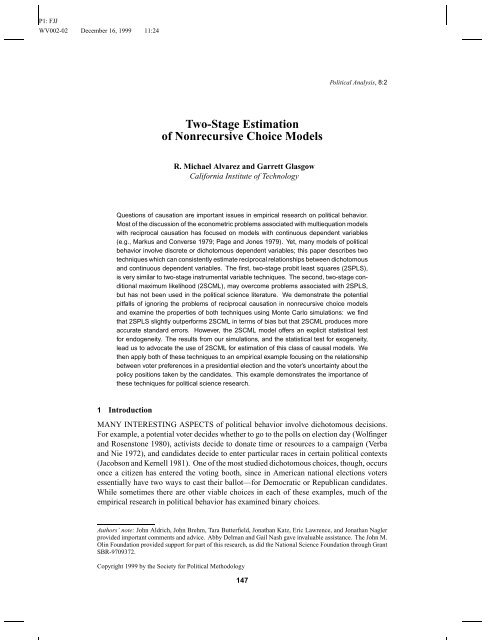
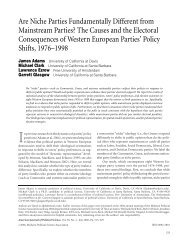
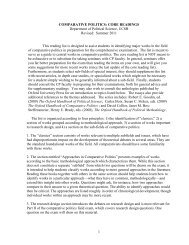
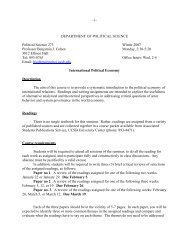

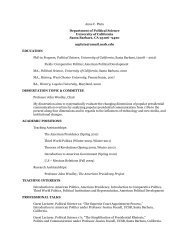
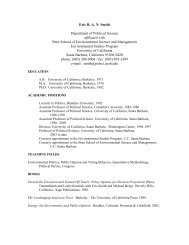
![Curriculum Vitae [abbreviated] John T. Woolley Professor of Political ...](https://img.yumpu.com/25423597/1/190x245/curriculum-vitae-abbreviated-john-t-woolley-professor-of-political-.jpg?quality=85)
